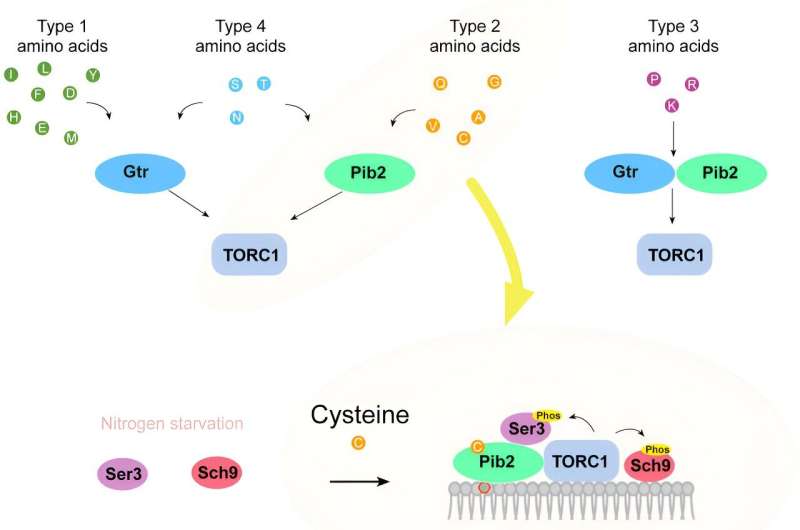This article has been reviewed according to Science X's editorial process and policies. Editors have highlighted the following attributes while ensuring the content's credibility:
fact-checked
peer-reviewed publication
trusted source
proofread
Researchers discover how cysteine activates a key regulator of cell growth in yeast

Amino acids are the building blocks of life. We obtain them from the food we eat, and the body uses them to make proteins, which in turn are used for growth, development, and a multitude of other functions. However, before the body can build with these blocks, it must first be able to sense their presence.
When amino acids are available, a master regulator protein called TORC1 is switched on, causing proteins to be manufactured and cells to grow. If no amino acids are available, TORC1 is switched off, and cells start to recycle themselves in a process known as autophagy. Until now, it was unclear exactly how amino acids triggered the TORC1 switch in yeast.
Now, in a study published in Cell Reports, researchers from Osaka University have revealed how TORC1 is activated: detection of the amino acid cysteine.
"We investigated the relationships between amino acids and TORC1 activation in the yeast Saccharomyces cerevisiae," says the study's lead author Qingzhong Zeng. "We found that cysteine is sensed by a protein called Pib2 and that the two bind together and activates TORC1. This stimulates the synthesis of proteins and lipids, promoting cell proliferation."
What's more, cysteine is not the only amino acid that triggers TORC1. All 20 amino acids were found to differently affect TORC1 using two "pathways": Pib2 and Gtr. A pathway can be thought of as a specific chain reaction that leads to certain outcomes in a cell. The team set out to elucidate how each amino acid uses these pathways to affect TORC1.
"Some amino acids primarily use the Pib2 pathway, while others primarily use Gtr," explains senior author Takeshi Noda. "We also identified amino acids that can use either pathway and some that need both. This work excites us because it deepens our understanding of how amino acids control cell growth and autophagy, and how each amino acid is detected."
In humans, faulty TORC1 function has been linked to diseases like cancer, diabetes, and dementia. A fuller understanding of how TORC1 is switched on and off, and how each amino acid is detected, could help researchers find new treatments for these diseases—an exciting prospect indeed.
More information: Qingzhong Zeng et al, Pib2 is a cysteine sensor involved in TORC1 activation in Saccharomyces cerevisiae, Cell Reports (2023). DOI: 10.1016/j.celrep.2023.113599
Journal information: Cell Reports
Provided by Osaka University


















